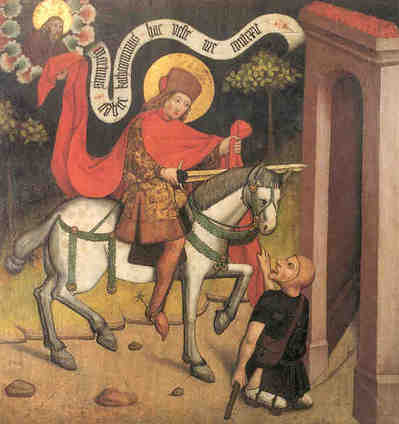
Martin of Tours meets the beggar and is blessed by Christ because he gave the beggar 1/2 of his cloak.
Martin of Tours (died in November, 397) was a Bishop of Tours, whose shrine in France became a famous stopping-point for pilgrims on the road to Santiago de Compostela. Around his name much legendary material accrued, and he has become one of the most familiar and recognizable Christian saints. As he was born in what is now Szombathely, Hungary, spent much of his childhood in Pavia, Italy, and lived most of his adult life in France, he is considered a spiritual bridge across Europe.
From the late 4th century to the late Middle Ages, much of Western Europe, including Great Britain, engaged in a period of fasting beginning on the day after St. Martin’s Day, November 11. This fast period lasted 40 days, and was, therefore, called Quadragesima Sancti Martini, which means in Latin “the forty days of St. Martin.” At St. Martin’s eve and on the feast day, people ate and drank very heartily for a last time before they started to fast. This fasting time was later called “Advent” by the Church and was considered a time for spiritual preparation for Christmas.
On St. Martin’s Day, children in Flanders, the southern and north-western parts of the Netherlands, and the Catholic areas of Germany and Austria still participate in paper lantern processions. Often, a man dressed as St. Martin rides on a horse in front of the procession. The children sing songs about St. Martin and about their lanterns. The food traditionally eaten on the day is goose, a rich bird. According to legend, Martin was reluctant to become bishop, which is why he hid in a stable filled with geese. The noise made by the geese betrayed his location to the people who were looking for him.
In the east part of the Belgian province of East-Flanders (Aalst) and the west part of West Flanders (Ypres), traditionally children receive presents from St. Martin on November 11, instead of from Saint Nicholas on December 6 or Santa Claus on December 25. They also have lantern processions, for which children make lanterns out of beets. In recent years, the lantern processions have become widespread as a popular ritual, even in Protestant areas of Germany and the Netherlands (even though most Protestant churches no longer officially recognize Saints).
